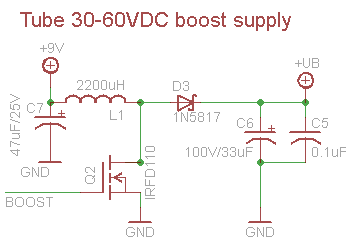Here is the calculator for DC to DC Conversion parameters:
Show us some love, like us on Facebook: www.facebook.com/embeddedsystems
Reference: www.ladyada.net
For many small projects, its cheaper and easier to DIY a boost converter than to buy a specialty chip. DIY converters are usually not as efficient but they're quick & cheap!


The above schematic section shows how I designed a 30-60V vacuum fluorescent tube display driven from a microcontroller pin.
Tubes such as VFDs, Nixies, Decatrons, etc require high voltage to light the gas in the tube. In order to reduce cost, we use a microconrtoller to make a boost converter and avoid paying $5 for a seperate chip. We can do this because we don't need a precision output and the current draw is mostly constant. The boost regulator is run open-loop there is no feedback resistor divider as it isn't necessary as long as the input voltage is within a reasonable range
The microcontroller runs at 8MHz so the 8-bit PWM output is 31250 Hz. The inductor and output capacitor is calculated below. The diode is a standard Schottkey type, but make sure you specify one that can handle the full voltage difference and peak current. The switch just has to be able to handle the max voltage plus some for safety. Note that this design is meant for 'static' output currents, not for variable current draw designs. There is no feedback and its very approximate! This is not for precision electronics!
The boost circuit works by connecting the power inductor L1 to ground that current can flow through it by turning on Q2. After a little bit of time, we disconnect the from ground (by turning off Q2) this means that there is no longer a path for the current in L1 to flow to ground. When this happens, the voltage across the inductor increases (this is the electric property of inductors) and charges up C6 . When the voltage increases to the level we want it to be (30V+) we turn on Q2 again which allows the current in L1 to flow back to ground. If we do this fast enough, and C6 large enough, the voltage onC6 is smoothed out and we get a nice steady high voltage
The timing of turning off/on Q2 allows us to modify the output voltage. Normally there is a feedback resistor to the microcontroller but it is not here because we are running it open-loop. To drive Q2 we use the PWM output from the microcontroller and adjust the duty cycle to vary brightness.
These sorts of designs can be easily made with a 555, once you have the PWM output, connect it up to Q2!
For this simple calculator, enter in the freqency, voltage ranges and current ranges and the duty cycle, inductor and current requirements will be displayed!The calculator
Don't forget that Duty cycle is the amount of time the switch is off / output is low. Be sure to measure the output voltages before connecting up anything important!
We like the J&W Miller / Bourns RLB9012 inductors and other thru-hole from the same company
We like the J&W Miller / Bourns RLB9012 inductors and other thru-hole from the same company
Show us some love, like us on Facebook: www.facebook.com/embeddedsystems
Reference: www.ladyada.net

 Posted in:
Posted in: 

0 comments:
Post a Comment